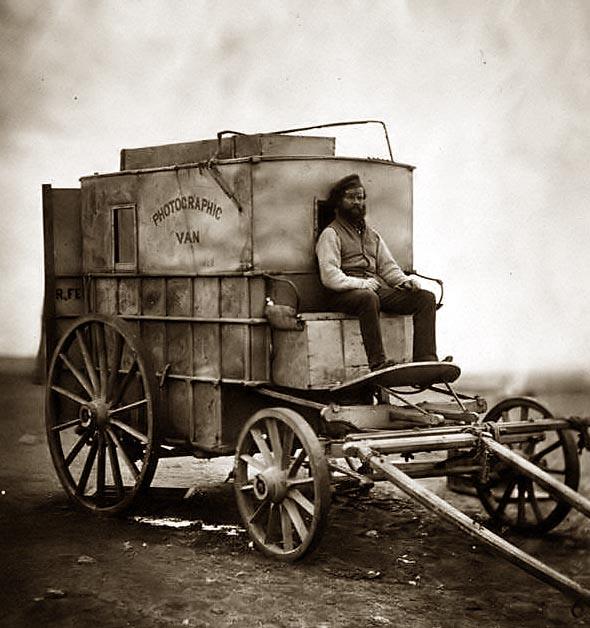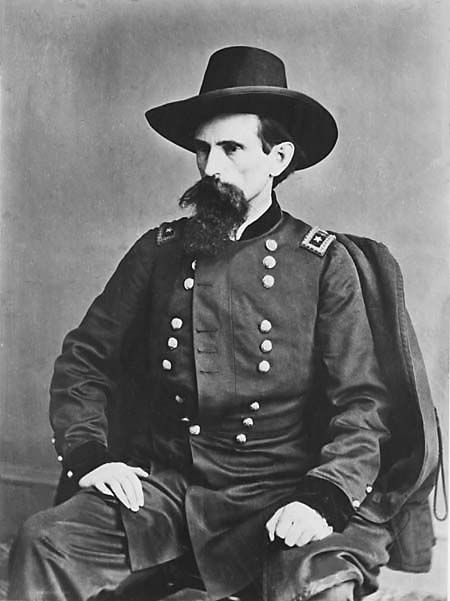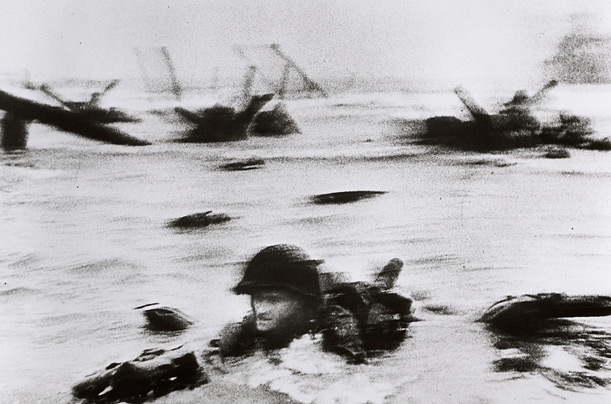
Photography in the 1860s was expensive, complex and heavy
There is a direct correlation between technology and grammar – that is a direct relationship between the way something is made, and the way it looks.
This is particularly true in the world of visual arts.
Photography in the 1860s required big cameras, dragging chemicals around in the field and shooting on chemically coated glass plates. The photo above is Matthew Brady’s set up to photograph the American Civil War. It was not easy, but he got some stunning images. The Civil War, in fact, is the first war that is actually photographed. Brady is the forerunner of the ’embedded journalists’ in Iraq today.
Brady’s cameras were big, heavy affairs. The ‘film’ plates were not so light sensitive and so exposure times were long. The cameras were placed atop tripods and the subjects were instructed to sit rigidly to have their photos taken.

General Lew Wallace, by Matthew Brady
Thus the technology of the time dictated the grammer, or the way the photographs looked.
Everyone sat bolt upright, stiff as a board; or the photographs were set up (in its infancy photography had yet to establish rules of staging – that would come later. The photographers of the Crimean War began serious staging as the actual battles were not place for big photo wagons!)
In the 1930s, two technological advances radically altered the grammar of photographer: The Leica company invented a small, hand held, high quality camera, and Agfa, the German film comany, replaced sheet film with a plastic 35mm roll film. One can only imagine the professionals who until then had used large filed cameras and produced massive negatives with no grain complaining about the ‘toy cameras’ and the small 35mm negatives!
The result, however, was a shift in the grammar of photo journalism. The formerly stiff, posed portraiture of Matthew Brady was supplanted by the ‘reality’ of the new photography. Photographers like Cartier Bresson or Capa embraced the new technology to create a new visual grammar.

American landing on Omaha Beach, D-Day by Robert Capa
Until very recently, video cameras were also big, heavy things. Professional photographers often went to work with vans, instead of wagons, to carry all the necessary gear.
The result was that the ‘grammar’ of video was all too similar to the grammar of early photography. Big, heavy and complex cameras militate toward stiff figures sitting upright in front of the camera. It is almost unavoidable:

Brian Williams, NBC News. Note the similarity to Gen. Lew Wallace
The great opportunity before us, as the medium gravitates toward these small, hand held cameras, is not to use them to ape what has already been a well established grammar in video with large cameras; but rather to embrace them to create a new grammar for video; one that has not been seen before.
I believe we can now do for television what Leicas did for photojournalism – that is, to turn it from a craft to an art form – to a far more compelling and intimate medium.
We are now just at the beginning of this moment. We can not know what this will become, and more than Matthew Brady might have contemplated what the work of Sebastao Salgado would have looked like. But we can try.
And as still photographers, particularly at newspapers, begin to pick up video cameras, there will be a tendency to imitate what television looks like now. That would be a mistake – and a unique opportunity lost.
As photojournalists, follow your own instincts as you wander into video – and help create a new grammar at the same time.
7 Comments
Cliff Etzel March 28, 2008
I have blogged today that the NPPA is reporting an increase in layoffs at traditional news stations in major markets – including award winning editors. The layoffs are being partly attributed to the slow increase in backpack or Solo Video Journalists.
In the posting on the NPPA’s website, an fortelling of what’s happening across this countries various traditional news stations has been discussed at great length many times here on Michaet’s blog:
My question is this:
If TV is such a great medium for viewership, why the severe drop in profits? My only guess is that people are bored to tears of the hair and teeth local news people and want something that intrigues them – not bores them. Local TV news does the latter.
If TV shooters really are suppose to be that good, then why the layoffs? If TV shooters are suppose to have the SKILLZ, why the same cookie cutter shots time after time?
If anything, this news only reaffirms the Solo Video Journalist paradigm. I hope this can be made into a positive thing for those TV shooters being affected by these layoffs now and those coming and that they can find this to be the catalyst for something greater for their craft.
Cliff Etzel March 25, 2008
I understand what you’re saying PG – I understand your position about Bourne not being shot on small cameras – the point I was trying to make was that the same techniques/principles of cinema can be applied to shooting small cameras for web broadcast/distribution.
I make no claims to be close to where more experienced shooters are – but I want to get there – and right now, shooting small cameras and targeting for web distribution is the first of many steps I and others are taking to get to a higher level of proficiency. Michael states the cost of admission is now open to virtually anyone – that is a good and not so good thing.
I understand how you feel about Michael’s teaching – I selectively take what I think is important and apply that, while others whom I seek for mentorship I apply as well. That way, I develop my own vision and hopefully make it into something that is worth viewing.
There are others whom I seek advice from who are moving the Solo VJ paradigm to new levels and seeing past the stigmas the traditionalists have set into place regarding equipment, set ways of acquiring footage and distribution venues.
No one person has all the answers. It’s each person’s responsibility to filter out what is accurate and what isn’t as it applies to them.
pencilgod March 25, 2008
Cliff I am a freelancer. I work for a wide rang of clients with an even wider range of cameras. Big, small, whatever. At the end of the day the production decides.
So I know that small cameras are slower and less agile than the big.
The Bourne Trilogy wasn’t shot on a small camera with a small crew.
With a small camera there are workarounds to get better pictures. But why would I as a cameraman, like working twice as hard to get the same or less quality just because the production wants to go cheap on the camera?
Its not about style or even snobbery. It’s about having the camera that gives the best result in the lest time vs a camera that will never look quite as good but costs a lot less.
Don’t kid yourself about new grammar of shooting, Michael doesn’t teach any grammar at all. One of his students’s spent 3 hours shooting a haircut for goodness sake!
Cliff Etzel March 25, 2008
PG – remember what newspapers are targeting – that being web distribution – the requirements for that form of content distribution is reflected in the requirements of gear. Although I do have issue with the notion that shoulder mount cameras are required even for broadcast when I constantly see the usage of DVX100’s, HVX200’s, Z1U’s, etc for such broadcast venues as The Travel Channel, TLC, Discovery, etc. I’m sure there is a time and place for such equipment for the kinds of work you shoot, but there is a new language of shooting that is coming to the surface that removes the usage of tripods and large cameras and replaces them with smaller, more agile tools for recording content. The language of cinema is beginning to play a big part in this (think Bourne Trilogy).
From your response you make the assumption that the Solo VJ paradigm needs to move forward… What makes you think it hasn’t already – VJ’ism isn’t only about shooting for broadcast now – web distribution is taking on a bigger role and the notion of having multi-thousand dollar shoulder mount cameras to make the claim of being a professional is presumptive at best. Just as Avid is going the way of the dinosaur, so to a certain extent is the shoulder mount camera and what it represents for content acquisition. According to some of the U/W shooters in the know, XDCAM EX 35mbps files are accepted as Silver level for Discovery HD, along with XDCAM HD. Silver means main capture (100%) format. As for Nat Geo Channel, they apparently have also accepted the XDCAM HD 35mbps for unrestricted capture. According to your perspective – that shouldn’t be so. Yet, the EX1 is an upper level prosumer handheld camera – One that didn’t exist just a year ago. That trickle down effect is going to hit at the consumer level cameras and then what will be the excuse then? I can add a shoulder mount similar to this to my pair of HC7’s quite easily – so I have the option of going both ways. True they aren’t the so called real deal, but I have the ability to go handheld, figrig, shoulder mount, monopod or tripod. And for web distribution of content, they do quite nicely and can go to broadcast in a pinch if needed.
I use to think photographers were the gear snobs – I was mistaken – traditional videographers take the award for that category.
pencilgod March 24, 2008
Ironically you have it completely backward. The little handycams have a lot more limitations than the bigger professional cameras. To get anywhere near the standards of big cameras with the un-ergonomic small ones you need to control a lot more of the environment. They are a backward step. Honestly there is nothing you can do with a small camera that I can’t do to a better standard in less time with a big one.
Nothing.
The difference in ‘grammar’ if you like is that you are teaching the equivalent of txt language… the language of shooting without any vowels… it might seem hip and groovy but lets face it nobody really wants to read a whole book in txt and nobody will really want to watch your half assed VJ stories.
Try teaching the whole alphabet then we’ll move onto grammar.
I think that it is the biggest problem I have with the VJ concept. You want me to move backward in almost every aspect of what I do. Try bringing your VJ model forward and then it might be worthwhile. .
pencilgod March 24, 2008
Ironically you have it completely backward. The little handycams have a lot more limitations than the bigger professional cameras. To get anywhere near the standards of big cameras with the un-ergonomic small ones you need to control a lot more of the environment. Honestly there is nothing you can do with a small camera that I can’t do to a better standard in less time with a big one. Nothing.
The difference in ‘grammar’ if you like is that you are teaching the equivalent of txt language… the language of shooting without any vowels… it might seem hip and groovy but lets face it nobody really wants to read a whole book in txt and nobody will really want to watch your half assed stories.
Try teaching the whole alphabet then well move onto grammar.
Cliff Etzel March 24, 2008
You touch on a fundamental discourse that is currently being discussed by all who are making the transition to video that work in newspaper. There is a sense of fear that pervades the various venues related to shooting video at the newspaper level – fear. Fear that if one makes a mistake, somehow their job is in jeopardy – the topic which you have touched on many times Michael – it is better to be safe than take a chance on something that might be better. Thus the catch-22 cycle presents itself in a whole new realm of video journalism. They seem to once again imitate the stagnate, boring crap that is the entrenched way of shooting content – for fear of making a mistake.
It gets quite old seeing the sheeple of this profession following in the footsteps of those who are creating the bland pablum that currently pervades the video journalism profession. A refreshing discourse David Dunkley-Gyimah and I have begun discussing the notion of the solo video journalist paradigm incorporating the new language of cinema as a part of the production process of shooting Solo VJ content. Imagine the unique stories that could be told with that shift in production values.
But it seems it’s better to play it safe and not make any waves with the current state of the photojournalism profession and newspaper layoffs.
I couldn’t agree more – it’s an ongoing discovery process for myself and my fellow photojournalists making the transition to the solo video journalist paradigm.